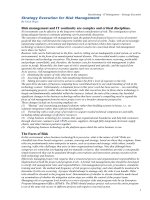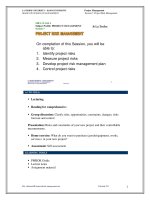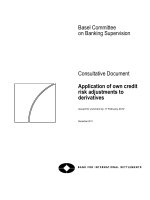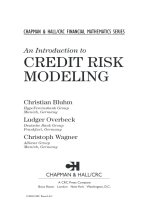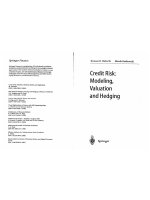Credit Risk measurement ppt
Bạn đang xem bản rút gọn của tài liệu. Xem và tải ngay bản đầy đủ của tài liệu tại đây (3.39 MB, 336 trang )
Credit Risk
measurement
Founded in 1807, John Wiley & Sons is the oldest independent publishing
company in the United States. With offices in North America, Europe, Aus-
tralia, and Asia, Wiley is globally committed to developing and marketing
print and electronic products and services for our customers’ professional
and personal knowledge and understanding.
The Wiley Finance series contains books written specifically for finance
and investment professionals as well as sophisticated individual investors
and their financial advisors. Book topics range from portfolio management
to e-commerce, risk management, financial engineering, valuation and fi-
nancial instrument analysis, as well as much more.
For a list of available titles, visit our Web site at www.WileyFinance.com.
Credit Risk
New Approaches to Value at Risk
and Other Paradigms
Second Edition
ANTHONY SAUNDERS
LINDA ALLEN
John Wiley & Sons, Inc.
measurement
Copyright © 2002 by Anthony Saunders and Linda Allen. All rights reserved.
Published by John Wiley & Sons, Inc., New York.
No part of this publication may be reproduced, stored in a retrieval system or transmitted in
any form or by any means, electronic, mechanical, photocopying, recording, scanning or
otherwise, except as permitted under Section 107 or 108 of the 1976 United States Copyright
Act, without either the prior written permission of the Publisher, or authorization through
payment of the appropriate per-copy fee to the Copyright Clearance Center, 222 Rosewood
Drive, Danvers, MA 01923, (978) 750-8400, fax (978) 750-4744. Requests to the Publisher
for permission should be addressed to the Permissions Department, John Wiley & Sons, Inc.,
605 Third Avenue, New York, NY 10158-0012, (212) 850-6011, fax (212) 850-6008,
E-Mail:
This publication is designed to provide accurate and authoritative information in regard to
the subject matter covered. It is sold with the understanding that the publisher is not engaged
in rendering professional services. If professional advice or other expert assistance is required,
the services of a competent professional person should be sought.
This title is also available in print as ISBN 0-471-21910-X. Some content that appears in the
print version of this book may not be available in this electronic edition.
For more information about Wiley products, visit our web site at www.Wiley.com
v
preface to second edition
I
t is quite astonishing that the state of the credit risk measurement art has
progressed so far in just two years. Many of the models are entering their
second generation. A consensus has developed about certain model param-
eters and approaches. As is perhaps inevitable for a maturing body of
knowledge, two schools of thought have emerged. One “school” traces its
intellectual roots to Merton’s options theoretic approach and explains de-
fault in structural terms related to the market value of the firm’s assets as
compared to its debt obligations. The other “reduced form school” statisti-
cally decomposes observed risky debt prices into default risk premiums that
price credit risk events without necessarily examining their underlying
causalities.
The need for books such as this one has increased as regulatory and
market conditions encourage greater proliferation of credit risk models. We
have tried to be faithful to the original book’s paradigm and present the eco-
nomic intuition of each of the models accurately, but in terms that are acces-
sible to a reader without a PhD in quantum mechanics. We start with a look
back. Chapter 1 describes recent conditions that have made advances in
credit risk measurement both desirable and attainable. Chapter 2 describes
traditional approaches. Chapter 3 includes comprehensive coverage of the
proposed BIS New Capital Accord with commentary. The new models are
described in Chapters 4 through 9, with portfolio models described in Chap-
ters 10 and 11. In this edition, we more clearly delineate the options theo-
retic approach (Chapter 4) from the reduced form approach (Chapter 5).
Back-testing models are described in Chapter 12. Applications to internal
capital allocation using RAROC models are presented in Chapter 13 and
off-balance-sheet credit risk measurement is covered in Chapters 14 and 15.
Finally, we would like to thank Victoria Ivashina, Dina Layish, Indrani
de Basak, and Farah Yunus for excellent research assistance and Bill Falloon
for being such an accommodating editor at John Wiley & Sons. The stan-
dard caveat with regard to responsibility for errors applies here as well.
A
NTHONY
S
AUNDERS
L
INDA
A
LLEN
New York, New York
January 2002
vii
preface to first edition
I
n recent years, enormous strides have been made in the art and science of
credit risk measurement and management. Much of the energy in this area
has resulted from dissatisfaction with traditional approaches to credit risk
measurement and with the current Bank for International Settlements (BIS)
regulatory model. Specifically, under the current regulatory structure, estab-
lished by the BIS in 1988 in cooperation with the world’s major central
banks, and implemented in January 1993, virtually all private-sector loans
are subject to an 8 percent capital requirement with no account being taken
of either: (1) credit quality differences among private-sector borrowers or
(2) the potential for credit risk reduction via loan portfolio diversification.
The new models—some publicly available and some partially propri-
etary—seek to offer alternative “internal model” approaches to measuring
the credit risk of a loan or a portfolio of loans. As with market risk in 1993,
a debate currently rages as to the extent to which internal models can re-
place regulatory models—and in which areas of credit risk measurement and
management.
Much of the research in this area has been quite technical and not eas-
ily accessible to the interested practitioner, student, economist, or regulator.
The aim of this book is to bring the debate regarding the “value” of the new
internal credit risk models to a wider audience. In doing so, I have tried to
simplify the technical details and analytics surrounding these models, while
concentrating on their underlying economics and economic intuition.
In many cases, providing a full description of the new models has been
hampered because of their semiproprietary nature and because only parts
of the modeling approach have been made publicly available through work-
ing papers, published papers, and other outlets. Thus, many model details
are “translucent” rather than transparent.
*
I have tried to be as accurate as
possible in describing the different models. Where the full details of a mod-
eling approach are uncertain or unclear, I have used the description “type,”
as in a “KMV-type” model. This is an indication (1) of my understanding of
the general approach used or (2) that a similar approach has been followed
in the publicly available literature by other researchers.
*I’d like to thank Stuart Turnbull of CIBC for this description.
viii PREFACE TO FIRST EDITION
This literature is very new. At the time of writing, it can be regarded as
being at a stage similar to that of market risk modeling when J.P. Morgan’s
RiskMetrics first appeared in 1994.
The book follows a “building blocks” approach. Chapter 1 provides
the motivation for the recent growth of the new credit risk models. Chapter
2 briefly overviews traditional models of credit risk measurement. Chapters
3 through 8 examine the approaches of the new models to evaluating indi-
vidual borrower (or counterparty) credit risk and to the valuation of indi-
vidual loans. One of the major features of the newer models is that they
consider credit risk in a portfolio context; consequently, Chapters 9 through
12 examine the application of modern portfolio theory concepts to evalua-
tion of the risk of loan portfolios. Finally, many of the new models are
equally applicable to assessing credit risk off-balance-sheet as well as on-
balance-sheet. Thus, Chapters 13 and 14 look at the application of the new
models to assessing the risk of derivative contracts, and the use of such con-
tracts in managing credit risk.
I thank a number of people for their encouragement, insights, and
comments. They include, in no particular order: Mark Carey, Lazarus
Angbazo, Frank Diebold, Larry Wall, Jim Gilkeson, Kobi Boudoukh,
Anthony Morris, Sinan Cebonoyan, Marti Subrahmanyam, Ranga Sun-
daram, Anil Ban
gia, Anand Srinivasan, Sreedhar Bharath, Alex Shapiro,
and Til Schuermann. Finally, I’d like to thank my colleague, Ed Altman, for
encouraging me to look into this area and for keeping the “torchlight” of
credit risk analysis burning during the past 30 years. Nevertheless, at the
end of the day, I take full responsibility for any errors of omission or com-
mission that may be found here.
A
NTHONY
S
AUNDERS
New York, New York
May 1999
ix
contents
LIST OF ABBREVIATIONS xi
CHAPTER 1
Why New Approaches to Credit Risk Measurement
and Management? 1
CHAPTER 2
Traditional Approaches to Credit Risk Measurement 9
CHAPTER 3
The BIS Basel International Bank Capital Accord: January 2002 23
CHAPTER 4
Loans as Options: The KMV and Moody’s Models 46
CHAPTER 5
Reduced Form Models: KPMG’s Loan Analysis System and
Kamakura’s Risk Manager 67
CHAPTER 6
The VAR Approach: CreditMetrics and Other Models 84
CHAPTER 7
The Macro Simulation Approach: The CreditPortfolio View
Model and Other Models 107
CHAPTER 8
The Insurance Approach: Mortality Models and the CSFP Credit
Risk Plus Model 121
x CONTENTS
CHAPTER 9
A Summary and Comparison of New Internal Model Approaches 135
CHAPTER 10
Overview of Modern Portfolio Theory and Its Application to
Loan Portfolios 151
CHAPTER 11
Loan Portfolio Selection and Risk Measurement 157
CHAPTER 12
Stress Testing Credit Risk Models: Algorithmics Mark-to-Future 191
CHAPTER 13
Risk-Adjusted Return on Capital Models 201
CHAPTER 14
Off-Balance-Sheet Credit Risk 213
CHAPTER 15
Credit Derivatives 233
BIBLIOGRAPHY 258
NOTES 276
INDEX 311
xi
list of abbreviations
ABS asset backed security
AE average exposure
AMA advanced measurement approach
ARS adjusted relative spread
BIS Bank for International Settlements
BISTRO Broad Index Secured Trust Offering
BRW benchmark risk weight
BSM Black–Scholes–Merton Model
CAPM capital asset pricing model
CDO collateralized debt obligation
CDS credit default swap
CLN credit-linked note
CLO collateralized lending obligation
CMR cumulative mortality rate
CS credit spread
CSFP Crédit Suisse Financial Products
CWI creditworthiness index
CYC current yield curve
DD distance to default
DM default mode model
EAD exposure at default
EBITDA
earnings before interest, taxes, depreciation, and amortization
EC European Community
ECA Export Credit Agency
EDF expected default frequency
EDP estimated default probability
EE expected exposure
EL expected losses
EVA economic value added
EVT extreme value theory
FA foundation approach
FIs financial institutions
FV future value
xii LIST OF ABBREVIATIONS
FX foreign exchange
FYC forward yield curve
GEV generalized extreme value
GPD Generalized Pareto Distribution
GSF granularity scaling factor
IDR implied debenture rating
IIF Institute of International Finance
IMF International Monetary Fund
IRB internal ratings-based model
ISDA International Swaps and Derivatives Association
LAS Loan Analysis System (KPMG)
LDCs less developed countries
LGD loss given default
LIBOR London Inter-Bank Offered Rate
M maturity
MD modified duration
MMR marginal mortality rate
MPT modern portfolio theory
MRC marginal risk contribution
MTM mark-to-market model
NAIC National Association of Insurance Commissioners
NASD National Association of Securities Dealers
NGR net to gross (current exposure) ratio
NPV net present value
NRSRO nationally recognized statistical rating organization
OAEM other assets especially mentioned
OBS off-balance-sheet
OCC Office of the Comptroller of the Currency
OECD Organization for Economic Cooperation and Development
OPM option-pricing model
OTC over-the-counter
PD probability of default
QDF quasi default frequency
QIS Quantitative Impact Study
RAROC risk-adjusted return on capital
RBC risk-based capital
Repo repurchase agreement
RN risk-neutral
ROA return on assets
ROE return on equity
RORAC return on risk-adjusted capital
RW risk weight
List of Abbreviations xiii
RWA risk weighted assets
SBC Swiss Bank Corporation
SM standardized model
SPV special-purpose vehicle
UL unexpected losses
VAR value at risk
WACC weighted-average cost of capital
WAL weighted average life
WARR weighted-average risk ratio
ZYC zero yield curve
Credit Risk
measurement
1
CHAPTER
1
Why New Approaches to
Credit Risk Measurement
and Management?
I
n recent years, a revolution has been brewing in risk as it is both measured
and managed. Contradicting the relatively dull and routine history of
credit risk, new technologies and ideas have emerged among a new genera-
tion of financial engineering professionals who are applying their model-
building skills and analysis to this area.
The question arises: Why now? There are at least seven reasons for this
sudden surge in interest.
1. STRUCTURAL INCREASE IN BANKRUPTCIES
Although the most recent recession hit at different times in different coun-
tries, most statistics show a significant increase in bankruptcies, compared
to the prior recessions. To the extent that there has been a permanent or
structural increase in bankruptcies worldwide—possibly due to the increase
in global competition—accurate credit risk analysis becomes even more im-
portant today than in the past.
2. DISINTERMEDIATION
As capital markets have expanded and become accessible to small and mid-
size firms (e.g., it is estimated that as many as 20,000 U.S. companies have
actual or potential access to the U.S. commercial paper market), the firms
or borrowers “left behind” to raise funds from banks and other traditional
financial institutions (FIs) are increasingly likely to be smaller and to have
2 CREDIT RISK MEASUREMENT
weaker credit ratings. Capital market growth has produced a “winner’s
curse” effect on the credit portfolios of traditional FIs.
3. MORE COMPETITIVE MARGINS
Almost paradoxically, despite the decline in the average quality of loans (de-
scribed above), interest margins or spreads, especially in wholesale loan
markets, have become very thin. In short, the risk-return trade-off from
lending has gotten worse. A number of reasons can be cited, but an impor-
tant factor has been the enhanced competition for lower quality borrowers,
especially from finance companies, much of whose lending activity has
been concentrated at the higher risk/lower quality end of the market.
4. DECLINING AND VOLATILE VALUES
OF COLLATERAL
Concurrent with recent Asian and Russian debt crises, banking crises in
well-developed countries such as Switzerland and Japan have shown that
property values and real asset values are very hard to predict and to realize
through liquidation. The weaker (and more uncertain) collateral values are,
the riskier lending is likely to be. Indeed, current concerns about “defla-
tion” worldwide have accentuated concerns about the value of real assets
such as property and other physical assets.
5. THE GROWTH OF OFF-BALANCE-SHEET
DERIVATIVES
Because of the phenomenal expansion of derivative markets, the growth of
credit exposure, or counterparty risk, has extended the need for credit
analysis beyond the loan book. In many of the very largest U.S. banks, the
notional (not market) value of off-balance-sheet exposure to instruments
such as over-the-counter (OTC) swaps and forwards is more than 10 times
the size of their loan books. Indeed, the growth in credit risk off the balance
sheet was one of the main reasons for the introduction, by the Bank for In-
ternational Settlements (BIS), of risk-based capital (RBC) requirements in
1993. Under the BIS system, banks have to hold a capital requirement based
on the mark-to-market current value of each OTC derivatives contract (so-
called current exposure) plus an add-on for potential future exposure (see
Chapter 14).
Why New Approaches to Credit Risk Measurement and Management? 3
6. TECHNOLOGY
Advances in computer systems and related advances in information technol-
ogy—for example, the development of historic loan databases by the Loan
Pricing Corporation and other companies—have given banks and FIs the
opportunity to test high-powered modeling techniques. A survey conducted
by the International Swaps and Derivatives Association (ISDA) and the In-
stitute of International Finance (IIF) in 2000 found that survey participants
(consisting of 25 commercial banks from 10 countries, with varying sizes
and specialties) used commercial and internal databases to assess the credit
risk on rated and unrated commercial, retail, and mortgage loans.
1
For ex-
ample, besides being able to analyze loan loss and value distribution func-
tions—and (especially) the tails of such distributions—FIs can move toward
actively managing loan portfolios based on modern portfolio theory (MPT)
models and techniques.
2
7. THE BIS RISK-BASED CAPITAL REQUIREMENTS
Despite the importance of these six reasons, probably the greatest incentive
for banks to develop new credit risk models has been dissatisfaction with
the BIS and central banks’ post-1992 imposition of capital requirements on
loans, so-called BIS I. The current BIS approach has been described as a
“one-size-fits-all” policy; virtually all loans to private-sector counterparties
are subjected to the same 8 percent capital ratio (or capital reserve require-
ment), irrespective of the size of the loan, its maturity, and, most impor-
tantly, the credit quality of the borrowing counterparty. Thus, loans to a
firm near bankruptcy are treated (in capital requirement terms) in the same
fashion as loans to an AAA borrower. Further, the current capital require-
ment is additive across all loans; there is no allowance for lower capital re-
quirements because of a greater degree of diversification in the loan
portfolio.
At the beginning of 1998, in the United States (1997, in the European
Community), regulators allowed certain large banks the discretion to calcu-
late capital requirements for their trading books—or market risk expo-
sures—using “internal models” rather than the alternative regulatory
(“standardized”) model. Internal models have had certain constraints im-
posed on them by regulators and are subjected to back-testing verification;
nevertheless, they potentially allow for (1) the Value at Risk (VA R ) of each
tradable instrument to be more accurately measured (e.g., based on its price
volatility, maturity, and so on) and (2) correlations among assets to be taken
into account. In the context of market risk, VA R measures the market value
4 CREDIT RISK MEASUREMENT
exposure of a financial instrument in case tomorrow is a statistically defined
“bad day.” For example, under the BIS market risk regulations, when banks
calculate their VA R -based capital requirements using their internal models,
they are required to measure the bad day as the one bad day that happens
every 100 business days. (See Appendix 1.1, in this chapter, for a summary
of basic VA R concepts.)
Much of the current interest in fine-tuning credit risk measurement
models has been fueled by the proposed BIS New Capital Accord (or so-
called BIS II), which would more closely link capital charges to the credit
risk exposures for individual retail, commercial, sovereign, and interbank
credits. Controversy regarding this proposal (discussed at length in Chapter
3) is evident from the one-year delay in finalization and implementation of
BIS II (now proposed to be implemented in 2005). This delay occurred be-
cause of difficulties in: agreeing on how credit risk should be modeled, tech-
nical problems arising from the nontradability of loans compared to
marketable instruments, and the lack of deep historic databases on loan de-
faults. For this reason, BIS II offers three alternative approaches to the cal-
culation of capital requirements for regulatory purposes: a standardized
approach (which utilizes external credit ratings to assess risk weights for
capital charges) and two separate internal ratings-based approaches (which
utilize the bank’s internal database to assess a loan’s default probability and
loss given default). The internal ratings-based approaches are patterned
after the market risk capital regulations using internal models, such that the
capital required is calibrated to cover a “bad credit period,” defined to be
the worst year out of 1,000 years.
3
Regardless of whether internal models are used to set bank capital re-
quirements, the new models have contributed to the lending process. Specif-
ically, internal models potentially offer better ways to value outstanding
loans and credit-risk-exposed instruments such as bonds (corporate and
emerging market), as well as better methods for predicting default risk ex-
posures to borrowers and derivative counterparties. Moreover, internal
models (1) allow (in many cases) the credit risk of portfolios of loans and
credit-risk-sensitive instruments to be better evaluated and (2) can be used
to improve the pricing of new loans, in the context of an FI’s risk-adjusted
return on capital (RAROC), as well as the pricing of relatively new instru-
ments in the credit-derivatives markets, such as credit options, credit swaps,
and credit forwards. Finally, the models provide an opportunity to measure
the privately optimal or economic amount of capital a bank (or FI) should
hold as part of its capital structure.
Before we look at some of these new approaches to credit risk mea-
surement, a brief analysis of the more traditional approaches will heighten
the contrast between the new and traditional approaches to credit risk
measurement.
Why New Approaches to Credit Risk Measurement and Management? 5
APPENDIX 1.1:
A BRIEF OVERVIEW OF KEY
VAR
CONCEPTS
The Role of Capital
Banks hold capital (mostly equity and long-term subordinated debt obliga-
tions) as a cushion against losses stemming from adverse credit, market, and
operational circumstances. By absorbing these losses, capital protects the
bank from insolvency. Bank regulators set minimum capital requirements so
as to reduce the likelihood of bank insolvencies that are costly to the econ-
omy. To determine how much capital should be required, two questions
must be answered. First, what is the acceptable probability of bank insol-
vency? It is neither practical nor desirable to completely indemnify the
banking system against all insolvencies; instead, an “acceptable” level of
risk is necessary to prevent moral hazard considerations that would encour-
age banks to take on excessive risk exposures. The proposed BIS II Internal
Ratings-Based model sets this risk threshold at the 99.9 percentile; that is,
the capital charge is sufficient to cover losses in all but the worst 0.1 percent
of adverse credit risk events. Stated directly: There is a 0.1 percent chance
that adverse credit conditions will cause bank insolvency.
Measuring Expected and Unexpected Losses
The second input into capital regulations is a methodology for measuring
losses in the event of adverse market conditions called credit events. Losses
are defined as the change in the security’s (loan’s) value over a fixed period
of time (“the credit horizon period”). Typically, the credit horizon period is
chosen to be one year. Thus, losses are calculated as the impact of a credit
event on the security’s market value,
4
less any cash flows received during the
one-year credit horizon period. Losses may be negative (that is, there are
gains) if the security’s value increases over the year and if a credit event does
not occur.
Figure 1.1 illustrates a loss distribution that relates all possible values of
securities’ losses/gains to the probability of occurrence for each value (de-
termined by the likelihood that a credit event will occur). The area under
the probability distribution of security losses must sum to one. The proba-
bility distribution in Figure 1.1 is a normal distribution, which suggests that
losses or gains are symmetrically distributed around the mean value. Two
important loss concepts are illustrated in Figure 1.1. Expected losses (EL)
are estimated by the mean of the distribution, and unexpected losses (UL)
are measured by the chosen percentile cutoff of extreme losses. If the loss
percentile cutoff is set at 0.1 percent (as in BIS II proposals), then UL is the
value that just marks off the shaded area in Figure 1.1, which comprises
6 CREDIT RISK MEASUREMENT
0.1
percent of the area under the entire loss distribution. That is, there is
only a 0.1 percent likelihood that losses will exceed UL. The UL is consid-
ered the measure of Value at Risk (VA R ).
The standard deviation, denoted σ, is a commonly used measure of risk
because it measures the loss dispersion around EL weighted by the likeli-
hood of occurrence. For the normal distribution, there is approximately a
67 percent probability that losses will fall within the region from EL−σ to
EL+σ, which is called the confidence interval.
The loss distribution shown in Figure 1.1 is normal, although most fi-
nancial loss distributions are skewed with fat tails; that is, there is a greater
likelihood of extreme outcomes than is shown by the normal distribution.
Figure 1.2 shows a skewed loss distribution with the loss measures EL and
UL. We can solve for the σ of the loss distribution in Figure 1.2, but because
it is not normal, we cannot specify the likelihood that losses will fall within
the EL−σ to EL +σ confidence interval unless we have information about
the particular shape of the distribution, for example, its skewness (lack of
symmetry) and its kurtosis (the probability of extreme loss outcomes).
FIGURE 1.1 Normal loss distribution.
Expected
Losses
(EL)
EL −σ EL +σ
Confidence
Interval
Unexpected
Losses, VAR
(UL)
Loss Distribution
Probability
%
99.9 Percentile
(Maximum) Value
0.1%
Why New Approaches to Credit Risk Measurement and Management? 7
Figures 1.1 and 1.2 are loss distributions for individual security (loan)
investments. However, diversification across different securities causes the
risk of a portfolio to be lower than the risk of individual security invest-
ments. The lower the correlation between pairs of securities, the greater the
benefits of diversification in reducing the risk of the portfolio. The correla-
tion coefficient, denoted ρ, measures the comovement between pairs of se-
curities on a scale of −1 to +1: −1 for perfectly negatively correlated (the
securities’ values move in exactly opposite directions), 0 for uncorrelated,
and +1 for perfectly positively correlated (the securities’ values move to-
gether in lock step). Most securities are positively correlated (thereby pre-
venting the elimination of risk through simple portfolio creation), but not
perfectly positively correlated (thereby providing substantial benefits to di-
versification).
As we will see in later chapters (for example, Chapter 6), estimating UL
(or VA R ) for credit risk is challenging. Not only do volatilities and correla-
tions have to be estimated for both probability of default (PD) and the loss
given default (LGD), but the definition of a credit event must also be deter-
mined. A credit event may be defined only as default, as in default mode
(DM) models. However, mark-to-market (MTM) models define a credit
event to be any migration in credit quality, including, but not limited to, de-
fault. Thus, if a particular loan or bond is downgraded from an A to a B rat-
ing, the adverse change in the bond’s price would be included in the loss
FIGURE 1.2 Skewed loss distribution.
Expected
Losses
(EL)
Unexpected
Losses, VAR
(UL)
Loss Distribution
Probability
%
8 CREDIT RISK MEASUREMENT
distribution of an MTM model, whereas it would not be included for a DM
model. Moreover, since credit events (particularly default) are somewhat
rare events, historical loss rates may not provide accurate estimates of fu-
ture exposures such as EL and UL. Finally, data availability problems plague
credit risk measurement models, in contrast to the market risk VA R models
that can use series of daily price databases. The challenge, for the modern
models of credit risk measurement, is to compensate for these problems.
